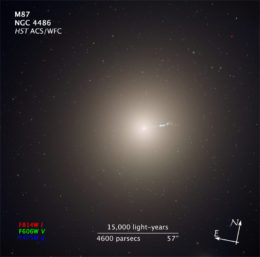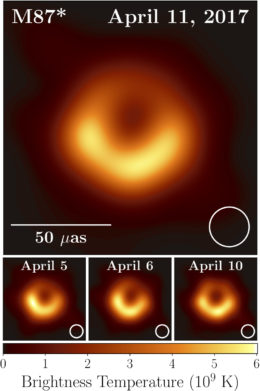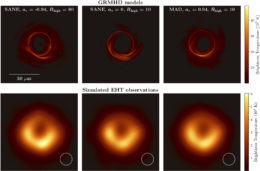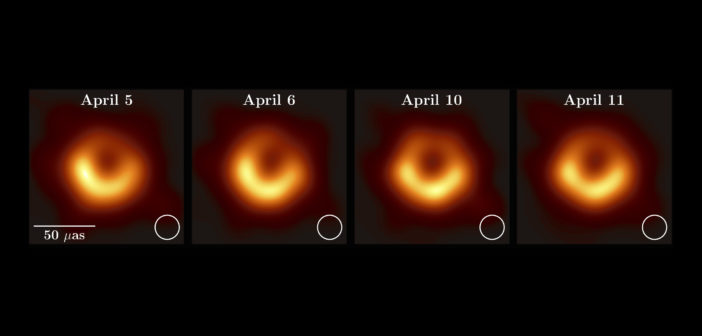Astronomers have used a telescope that spans the globe to capture the first detailed images of a black hole: the nearby supermassive black hole in the Messier 87 galaxy. The first results from the Event Horizon Telescope (EHT) are detailed in six articles that make up a new Focus Issue in The Astrophysical Journal Letters.

Hubble image of the elliptical galaxy M87, dominated by the visible jet extending to the northwest of the supermassive black hole at the galaxy’s center (click to enlarge). [NASA/ESA/Hubble Heritage Team (STScI/AURA)/P. Cote (Herzberg Institute of Astrophysics)/E. Baltz (Stanford University)]
Why M87?
Obtaining an up-close view of a black hole is a goal that has long remained out of reach. When astronomers first developed a plan to image a supermassive black hole’s event horizon — the close-in boundary from which not even light can escape — two sources were selected as targets: the black hole at the center of our galaxy, Sgr A*; and the gargantuan, jet-producing black hole in the neighboring galaxy M87.
Sgr A*, while the nearest supermassive black hole, suffers from a host of complicating factors for imaging. This monster’s rapid variability and its position in the galactic plane — where it’s blurred by the interstellar medium — provide additional challenges that must be overcome to accurately capture it.
M87 may be further away, but its black hole is a thousand times larger than Sgr A*, giving it longer and more manageable variability timescales. We’re also peering through much less of the interstellar medium when pointed at M87.
These factors contribute to making the neighboring behemoth in M87 comparatively accessible for imaging — and, consequently, it’s the first source for which the EHT is presenting images.
A Planet-Scale Telescope
So how do we zoom in on this distant object? We need a telescope unlike any other.

The eight stations of the EHT 2017 campaign over six geographic locations. [EHT Collaboration et al 2019]
The EHT works by performing very-long-baseline interferometry; by combining different telescopes around the world, the EHT can function like a telescope with an effective size that’s the same as its longest baseline — the distance between component telescopes. In this way, the EHT is able to achieve unprecedented resolution: it can theoretically resolve down to 25 millionths of an arcsecond at its observing wavelength of 1.3 mm.
It’s been more than a decade since the EHT’s bold imaging plans were first begun. Scientists have patiently waited as existing facilities were upgraded and new facilities have been built — and in April 2017, conditions were finally right to obtain the first good look at M87’s event horizon.
Images of a Shadow
M87’s black hole was observed on four days in April 2017. Weather was uniformly good — planet-wide! — during those observations, allowing EHT scientists to combine the data from the eight telescopes and reconstruct images of the black hole.

EHT observations of M87 taken over 4 days reveal a bright, asymmetric ring; north is up and east is left. The images remain consistent over the observations, providing evidence of a stable source. [EHT Collaboration et al 2019]
While a naked black hole would simply appear dark in an image, an active black hole like M87 is surrounded by dust and gas that forms an accreting disk, as well as funnels at the base of its powerful jets. Images of such an encased black hole were predicted to reveal a dark region — the black hole’s “shadow” — surrounded by a ring of emission produced by the distorted paths of light from the surrounding material. The EHT observations of M87 beautifully confirm this picture!
Why is the southern part of the ring brighter? As fast-moving material rotates around the black hole, it speeds toward us on one side and away from us on the other. On the side of the ring where matter moves toward us, a relativistic effect beams light in our direction, causing this region to appear brighter.
From the asymmetry of the ring, EHT scientists determine that matter on the south side of M87’s black hole is moving toward us. Combined with previous observations of M87’s jet, which show it’s inclined at an angle of 17° relative to our line of sight, this tells us that M87’s black hole likely spins clockwise from our point of view, with its spin axis pointed away from us at an angle.

Three of the authors’ example models of spinning black holes (top row) and their simulated observations (bottom row). All three models produce similar simulated observations that well-match the real observations, indicating a single good fit doesn’t imply that one model is preferred over the others. [EHT Collaboration et al 2019]
Models and Measurements
The EHT’s images of M87’s black hole were compared to an extensive library of synthetic observations obtained from simulations of this source under varying models and conditions. The simulated observations show remarkable consistency with the actual observations, confirming a picture of a spinning supermassive black hole as the source of the emission. The models also suggest the most likely way that M87’s jets are launched: via energy extraction directly from the black hole’s spin.
Previous estimates of the mass for M87’s black hole ranged from ~3–7 billion solar masses, depending on the method used to measure it. From the EHT’s images of M87, the authors were able to estimate a mass for the black hole of 6.5 ± 0.7 billion solar masses, providing an independent check of past measurements.
Future Plans
What’s next for the EHT? These images of M87 are just the start! The team still plans to perform polarimetric analysis of their images, which will probe the magnetic field and help determine the rate of accretion onto M87’s black hole. Future observations will test the stability, shape, and depth of its shadow more accurately. And higher-resolution images will be possible with the addition of new telescopes to the EHT and a possible push to shorter-wavelength observations.
Continued improvements to EHT’s observational technology and analysis techniques should also bring our own supermassive black hole, Sgr A*, into reach. Welcome to a new world of black-hole exploration!
For more information, check out the full ApJL Focus Issue here:
Focus on the First Event Horizon Telescope Results
Citation
“First M87 Event Horizon Telescope Results. I. The Shadow of the Supermassive Black Hole,” EHT Collaboration et al 2019 ApJL 875 L1. doi:10.3847/2041-8213/ab0ec7

22 Comments
Pingback: AAS Nova – New
Pingback: Live-Blog zum Event Horizon Telescope Reveal | Skyweek Zwei Punkt Null
Pingback: The Perplexing Physics of Imaging a Black Hole – SimpleNews
Pingback: The Perplexing Physics of Imaging a Black Hole – Back with the apostle of affordable luxury,
Pingback: The Perplexing Physics of Imaging a Black Hole - aka.COOL
Pingback: The Perplexing Physics of Imaging a Black Hole
Pingback: The Perplexing Physics of Imaging a Black Hole – On.Share.co.ve
Pingback: The Perplexing Physics of Imaging a Black Hole - MDSH
Pingback: The Perplexing Physics of Imaging a Black Hole
Pingback: - Mero Tribune
Pingback: hello darkness, my old friend! – transeunte macambúzio
Pingback: The Perplexing Physics of Imaging a Black Hole | IDM NEWS
Pingback: The Perplexing Physics of Imaging a Black Hole - Masoud ILDEREMI
Pingback: The Perplexing Physics of Imaging a Black Hole - TechMasair
Pingback: Daily Study Log (2019-04-10) | Study Astrophysics
Pingback: 算出黑洞照片的科學家凱蒂.包曼:「儘管未知,還是要踏出第一步。」 – 港澳熱點
Pingback: The Perplexing Physics of Imaging a Black Hole - Powered by InterDigitel
Pingback: The Perplexing Physics of Imaging a Black Hole – DA: Techout
Pingback: The Appearance of a Black Hole’s Shadow
Pingback: The latest in Ph-word: April 2020 part #2
Pingback: Selections from 2020: A Twinkling Black Hole
Pingback: Event Horizon Telescope Traces Magnetic Fields Around a Black Hole